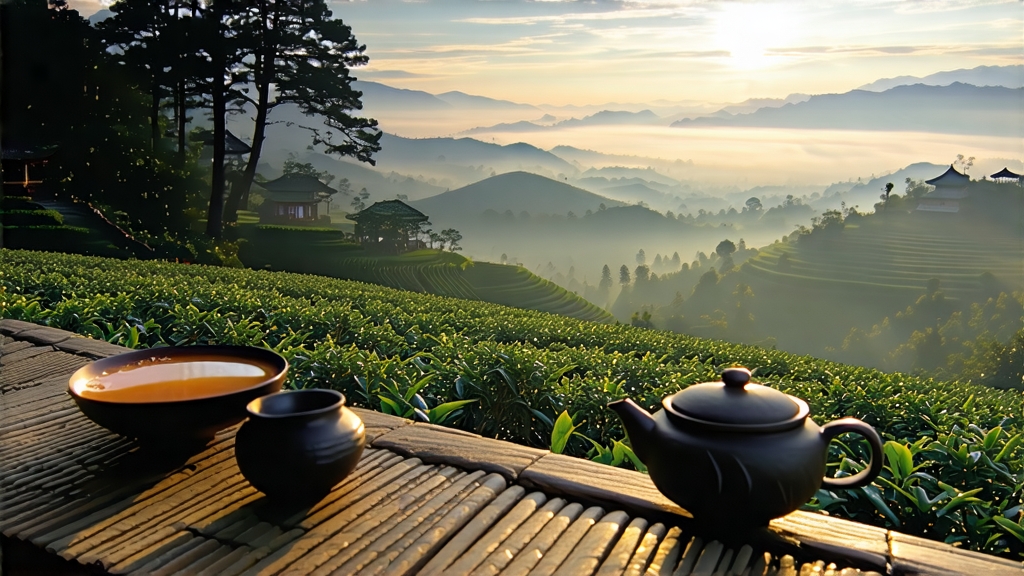
Alishan High-Mountain Oolong is the liquid echo of Taiwan’s central mountain range, a tea that carries the chill of 1,200-metre dawns and the perfume of evergreen forests. Although the cultivar itself—most often Qing Xin or Jin Xuan—was transplanted from mainland China in the nineteenth century, the tea’s modern identity was forged during the 1980s, when Taiwanese tea makers deliberately pushed their gardens above the cloud line in search of cooler nights and thicker fog. The gamble paid off: slower growth concentrated amino acids and aromatics, giving birth to a new stylistic paradigm that the world now calls “high-mountain oolong.” Today, any leaf bearing the Alishan appellation must be grown within the townships of Meishan, Zhuqi, Fanlu, or Alishan proper, and must be harvested at elevations between 1,000 and 1,400 metres. These rules, policed by both farmers’ cooperatives and competitive trade fairs, protect a reputation that rivals the crus of Burgundy.
The tea belongs to the semi-oxidised family, yet its oxidation seldom exceeds 25 %, landing it closer to a green oolong than to the amber-roasted styles of Fujian. What sets Alishan apart is not only altitude but also the rhythm of its seasons. In March, when the island’s lowlands already feel balmy, Alishan nights can dip to 8 °C. The cold shock forces the bush to metabolise more sucrose and glutamic acid, precursors to the lingering “sweet aftertaste” (huigan) that connoisseurs prize. Between March and May, and again from October to November, pickers climb narrow switchbacks before dawn, wearing headlamps and woven bamboo baskets strapped to their backs. Only the top two leaves and a half-open bud are plucked, a discipline known in Mandarin as “one heart two leaves,” ensuring the ideal ratio of polyphenols to soluble sugars.
Withering begins in the mountain air itself. The leaf is spread on large bamboo trays set outside the factory’s sliding doors, where it loses moisture under the high-UV sunlight of 10 a.m. After twenty minutes, the trays are rolled indoors onto wire racks; the sudden drop in temperature triggers a gentle enzymatic oxidation. Here the master’s hand appears: every half-hour he tosses the leaf skyward, letting it rain down in a green cascade. This “yin zao” dance bruises the edges just enough to liberate floral volatiles without rupturing the cell walls completely. Once the leaf’s rim turns jade with a faint mahogany rim, oxidation is halted in a cylindrical tumbling roaster set to 180 °C for ninety seconds. The roast is not yet the famous charcoal finish; it is merely a kill-green phase that locks in the bouquet.
Next comes the shaping. While mainland oolongs are often strip-shaped, Alishan pursues the半球形 (half-ball) style popularised throughout Taiwan. The leaf is wrapped in a square of cotton cloth, forming a tight bun that is then rolled under mechanical pressure for three minutes. The bundle is opened, fluffed, and re-wrapped in the opposite direction; this cycle repeats no fewer than thirty times over two hours. The result is a pea-green pellet that will later unfurl into a full leaf set in the cup. Between rolling cycles the tea is lightly baked at 80 °C, driving off residual moisture and coaxing a creamy lactone note reminiscent of fresh coconut.
The final, optional act is charcoal finishing. Many exporters request a “qing xiang” (light aroma) profile, skipping charcoal altogether to preserve high-pitched lilac and lily notes. Yet the traditionalists insist on a low-temperature charcoal bed of longan wood that smoulders for six to eight hours, never exceeding 60 °C. The wood’s resin infuses a whisper of smoked honey, while the prolonged heat polymerises catechins into theaflavins, deepening the liquor’s gold to an almost electric amber. Whether roasted or unroasted, the finished tea rests for a minimum of forty days in vacuum-sealed foil, a “marriage” period that rounds any harsh edges.
To brew Alishan properly, one must respect its mountain soul: cool, pure water and short steeps. Begin by warming a 120-ml gaiwan or petite Yixing teapot with 95 °C